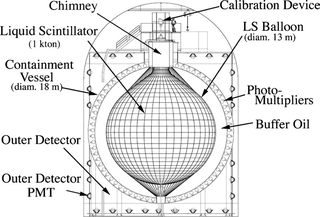Related Research Articles

A muon is an elementary particle similar to the electron, with an electric charge of −1 e and a spin of 1⁄2, but with a much greater mass. It is classified as a lepton. As with other leptons, the muon is not thought to be composed of any simpler particles; that is, it is a fundamental particle.

A neutrino is a fermion that interacts only via the weak interaction and gravity. The neutrino is so named because it is electrically neutral and because its rest mass is so small (-ino) that it was long thought to be zero. The rest mass of the neutrino is much smaller than that of the other known elementary particles excluding massless particles. The weak force has a very short range, the gravitational interaction is extremely weak due to the very small mass of the neutrino, and neutrinos do not participate in the strong interaction. Thus, neutrinos typically pass through normal matter unimpeded and undetected.

The GSI Helmholtz Centre for Heavy Ion Research is a federally and state co-funded heavy ion research center in the Wixhausen suburb of Darmstadt, Germany. It was founded in 1969 as the Society for Heavy Ion Research, abbreviated GSI, to conduct research on and with heavy-ion accelerators. It is the only major user research center in the State of Hesse.

In particle physics, a lepton is an elementary particle of half-integer spin that does not undergo strong interactions. Two main classes of leptons exist: charged leptons, and neutral leptons. Charged leptons can combine with other particles to form various composite particles such as atoms and positronium, while neutrinos rarely interact with anything, and are consequently rarely observed. The best known of all leptons is the electron.
In physics, mirror matter, also called shadow matter or Alice matter, is a hypothetical counterpart to ordinary matter.

Neutrino oscillation is a quantum mechanical phenomenon in which a neutrino created with a specific lepton family number can later be measured to have a different lepton family number. The probability of measuring a particular flavor for a neutrino varies between three known states, as it propagates through space.

In nuclear physics, double beta decay is a type of radioactive decay in which two neutrons are simultaneously transformed into two protons, or vice versa, inside an atomic nucleus. As in single beta decay, this process allows the atom to move closer to the optimal ratio of protons and neutrons. As a result of this transformation, the nucleus emits two detectable beta particles, which are electrons or positrons.

Double electron capture is a decay mode of an atomic nucleus. For a nuclide (A, Z) with a number of nucleons A and atomic number Z, double electron capture is only possible if the mass of the nuclide (A, Z−2) is lower.

The Kamioka Liquid Scintillator Antineutrino Detector (KamLAND) is an electron antineutrino detector at the Kamioka Observatory, an underground neutrino detection facility in Hida, Gifu, Japan. The device is situated in a drift mine shaft in the old KamiokaNDE cavity in the Japanese Alps. The site is surrounded by 53 Japanese commercial nuclear reactors. Nuclear reactors produce electron antineutrinos () during the decay of radioactive fission products in the nuclear fuel. Like the intensity of light from a light bulb or a distant star, the isotropically-emitted flux decreases at 1/R2 per increasing distance R from the reactor. The device is sensitive up to an estimated 25% of antineutrinos from nuclear reactors that exceed the threshold energy of 1.8 megaelectronvolts (MeV) and thus produces a signal in the detector.
Sterile neutrinos are hypothetical particles that are believed to interact only via gravity and not via any of the other fundamental interactions of the Standard Model. The term sterile neutrino is used to distinguish them from the known, ordinary active neutrinos in the Standard Model, which carry an isospin charge of ±+1/ 2 and engage in the weak interaction. The term typically refers to neutrinos with right-handed chirality, which may be inserted into the Standard Model. Particles that possess the quantum numbers of sterile neutrinos and masses great enough such that they do not interfere with the current theory of Big Bang nucleosynthesis are often called neutral heavy leptons (NHLs) or heavy neutral leptons (HNLs).
Inverse beta decay, commonly abbreviated to IBD, is a nuclear reaction involving an electron antineutrino scattering off a proton, creating a positron and a neutron. This process is commonly used in the detection of electron antineutrinos in neutrino detectors, such as the first detection of antineutrinos in the Cowan–Reines neutrino experiment, or in neutrino experiments such as KamLAND and Borexino. It is an essential process to experiments involving low-energy neutrinos such as those studying neutrino oscillation, reactor neutrinos, sterile neutrinos, and geoneutrinos. The IBD reaction can only be used to detect antineutrinos due to lepton conservation.

T2K is a particle physics experiment studying the oscillations of the accelerator neutrinos. The experiment is conducted in Japan by the international cooperation of about 500 physicists and engineers with over 60 research institutions from several countries from Europe, Asia and North America and it is a recognized CERN experiment (RE13). T2K collected data within its first phase of operation from 2010 till 2021. The second phase of data taking (T2K-II) is expected to start in 2023 and last until commencement of the successor of T2K – the Hyper-Kamiokande experiment in 2027.
SAGE is a collaborative experiment devised by several prominent physicists to measure the solar neutrino flux.

Borexino is a deep underground particle physics experiment to study low energy (sub-MeV) solar neutrinos. The detector is the world's most radio-pure liquid scintillator calorimeter and is protected by 3,800 meters of water-equivalent depth. The scintillator is pseudocumene and PPO which is held in place by a thin nylon sphere. It is placed within a stainless steel sphere which holds the photomultiplier tubes (PMTs) used as signal detectors and is shielded by a water tank to protect it against external radiation. Outward pointing PMT's look for any outward facing light flashes to tag incoming cosmic muons that manage to penetrate the overburden of the mountain above. Neutrino energy can be determined through the number of photoelectrons measured in the PMT's. While the position can be determined by extrapolating the difference in arrival times of photons at PMT's throughout the chamber.

Double Chooz was a short-baseline neutrino oscillation experiment in Chooz, France. Its goal was to measure or set a limit on the θ13 mixing angle, a neutrino oscillation parameter responsible for changing electron neutrinos into other neutrinos. The experiment uses reactors of the Chooz Nuclear Power Plant as a neutrino source and measures the flux of neutrinos they receive. To accomplish this, Double Chooz has a set of two detectors situated 400 meters and 1050 meters from the reactors. Double Chooz was a successor to the Chooz experiment; one of its detectors occupies the same site as its predecessor. Until January 2015 all data has been collected using only the far detector. The near detector was completed in September 2014, after construction delays, and started taking data at the beginning of 2015. Both detectors stopped taking data in late December 2017.

Modern searches for Lorentz violation are scientific studies that look for deviations from Lorentz invariance or symmetry, a set of fundamental frameworks that underpin modern science and fundamental physics in particular. These studies try to determine whether violations or exceptions might exist for well-known physical laws such as special relativity and CPT symmetry, as predicted by some variations of quantum gravity, string theory, and some alternatives to general relativity.
ICARUS is a physics experiment aimed at studying neutrinos. It was located at the Laboratori Nazionali del Gran Sasso (LNGS) where it started operations in 2010. After completion of its operations there, it was refurbished at CERN for re-use at Fermilab, in the same neutrino beam as the MiniBooNE, MicroBooNE and Short Baseline Near Detector (SBND) experiments. The ICARUS detector was then taken apart for transport and reassembled at Fermilab, where data collection is expected to begin in fall 2021.
Measurements of neutrino speed have been conducted as tests of special relativity and for the determination of the mass of neutrinos. Astronomical searches investigate whether light and neutrinos emitted simultaneously from a distant source are arriving simultaneously on Earth. Terrestrial searches include time of flight measurements using synchronized clocks, and direct comparison of neutrino speed with the speed of other particles.
The STEREO experiment investigates the possible oscillation of neutrinos from a nuclear reactor into light so-called sterile neutrinos. It is located at the Institut Laue–Langevin (ILL) in Grenoble, France. The experiment started operating and taking data in November 2016.
References
- ↑ "The Heavy Ion Storage Ring ESR". GSI. Archived from the original on 1 February 2017. Retrieved 19 February 2017.
- ↑ Atanasov, Dinko; et al. (2015). "Between atomic and nuclear physics: radioactive decays of highly-charged ions". Journal of Physics B: Atomic, Molecular and Optical Physics. 48 (14): 144024. Bibcode:2015JPhB...48n4024A. doi:10.1088/0953-4075/48/14/144024. ISSN 0953-4075. S2CID 120111482.
- ↑ Litvinov, Yu.A.; Bosch, F.; Winckler, N.; et al. (2008). "Observation of non-exponential orbital electron capture decays of hydrogen-like 140Pr and 142Pm ions". Physics Letters B. 664 (3): 162–168. arXiv: 0801.2079 . Bibcode:2008PhLB..664..162L. doi:10.1016/j.physletb.2008.04.062. ISSN 0370-2693. S2CID 15610236.
- ↑ Giunti, Carlo (2009). "The GSI Time Anomaly: Facts and Fiction". Nuclear Physics B: Proceedings Supplements. 188: 43–45. arXiv: 0812.1887 . Bibcode:2009NuPhS.188...43G. doi:10.1016/j.nuclphysbps.2009.02.009. ISSN 0920-5632. S2CID 10196271.
- ↑ Kienle, P.; Bosch, F.; Bühler, P.; Faestermann, T.; Litvinov, Yu.A.; Winckler, N.; et al. (2013). "High-resolution measurement of the time-modulated orbital electron capture and of the β+ decay of hydrogen-like 142Pm60+ ions". Physics Letters B. 726 (4–5): 638–645. arXiv: 1309.7294 . Bibcode:2013PhLB..726..638K. doi:10.1016/j.physletb.2013.09.033. ISSN 0370-2693. S2CID 55085840.
- ↑ Ozturk, F.C.; Akkus, B.; Atanasov, D.; Beyer, H.; Bosch, F.; Boutin, D.; Brandau, C.; Bühler, P.; Cakirli, R.B.; Chen, R.J.; Chen, W.D.; Chen, X.C.; Dillmann, I.; Dimopoulou, C.; Enders, W.; Essel, H.G.; Faestermann, T.; Forstner, O.; Gao, B.S.; Geissel, H.; Gernhäuser, R.; Grisenti, R.E.; Gumberidze, A.; Hagmann, S.; Heftrich, T.; Heil, M.; Herdrich, M.O.; Hillenbrand, P.-M.; Izumikawa, T.; et al. (2019). "New test of modulated electron capture decay of hydrogen-like 142Pm ions: Precision measurement of purely exponential decay". Physics Letters B. 797: 134800. arXiv: 1907.06920 . Bibcode:2019PhLB..79734800O. doi:10.1016/j.physletb.2019.134800. S2CID 196831969.
- Walker, Philip M. (2008). "Nuclear physics: A neutrino's wobble?". Nature . 453 (7197): 864–5. Bibcode:2008Natur.453..864W. doi: 10.1038/453864a . PMID 18548060. S2CID 4379155.
- "The Net Advance of Physics: VARIABILITY OF NUCLEAR DECAY RATES". maintains a collection of research papers on the GSI K-Capture Anomaly